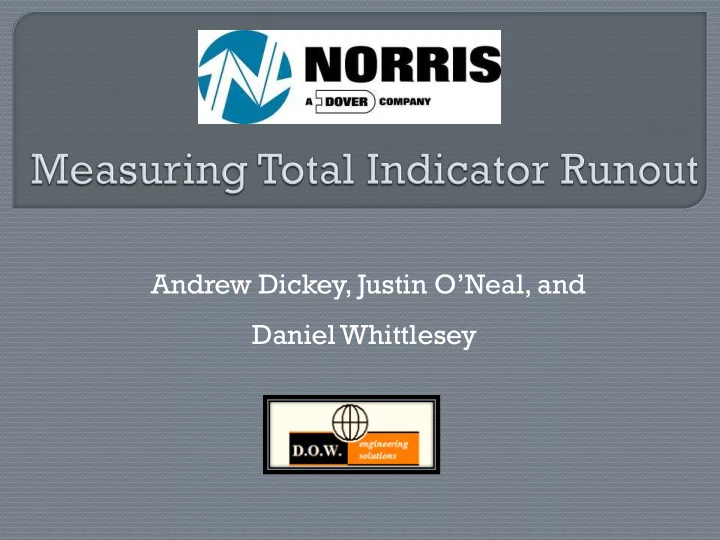

Andrew Dickey, Justin O’Neal, and Daniel Whittlesey
Danny Justin Andrew
o Headquartered in Tulsa, OK. o World’s leading manufacturer of sucker rods o Began in 1882 with wooden sucker rod production o Produced first metal rod o 6.4 million feet of rod produced each month
o Steel rod, 25’ - 30’in length o Used in the oil and gas industry o Joins surface and downhole components o Sizes from 5/8” – 1 1/8” o Various grades Image Source: http://sjvgeology.org/oil/pumpjack.jpg
o TIR is difference between the maximum and minimum readings of a dial indicator, or similar device, monitoring a face or cylindrical surface during one complete revolution of the monitored surface. o For sucker rods, TIR tolerances are governed by the American Petroleum Institute (API). o The tolerances are outlined in API Spec 11B.
o Develop a new system of checking for total indicator run out (TIR). System will be more user friendly and also be able to handle 15,000 rods per day. Proposed system will cut down on cycle time while meeting API specification. Currently: o Norris has equipment installed to check TIR o Only 10% of rods produced are checked for TIR o Discrepancy with third party o User interference
o A.6.2 End Straightness • A.6.2.1 Sucker Rods and Pony Rods End straightness shall be measured by supporting the rod body at a distance of 6.00 in. (152.4 mm) from the rod pin shoulder. The rest of the rod shall be supported at a maximum of 6.00 ft (1.83 m) with centers in the same plane. The amount of TIR bend is measured via a dial indicator, laser or other comparable measuring device. The amount of bend shall be measured at the machined surface of the pin shoulder OD. The maximum allowable TIR values for all rod sizes 5/8 in. to 11/8 in. (15.88 mm to 28.58 mm) is 0.130 in. (3.30 mm).
o Keyence shadow system o Pneumatic cylinders to push rods o East / West systems o East has spindle system to adjust for tolerance in rod length Disadvantages: Bulky Susceptible to user interference Expensive
o Linear Variable Displacement Transformer (LVDT) o Pneumatic cylinder to lift LVDT into place o Proximity sensor stop system o Roller system to move rods
o Proven technology o Compact o Ideal for harsh industrial environments o IP65 Environmental Rating o Stainless steel body Source: http://www.efunda.com/designstandards/sensors/lvdt/images/lvdt_how.gif
o ASTM F2537-06(2011) o USBR 1008-89 o Micrometer Method o Generated calibration curve with R 2 – values Source: https://nees.org/data/get/facility/RPI/TrainingAndCertification/OnSiteProcedures /LVDT%20Calibration%20Procedure.pdf
o Performed measurement system analysis (MSA) by conducting a gage R&R (repeatability and reproducibility) study o ANOVA (analysis of variance) technique o Followed guidelines for MSA: Using supplied rods (4 – 5/8” and 4 – 1” rods): o 3 appraisers o 3 trials o 10 parts
Verified using Ford Verification data.
o Keyence system o LS-7501 o Two sensors one controller o $13,000
Part Quantity Cost/Part ($) Total Cost($) Parker Solenoid Valve 1 98.95 98.95 Solid State Relay 3 31.86 95.58 Flow Control Valve 2 23.49 46.98 Pneumatic Quick Connect Fittings 10 2.35 23.50 1/4" Nylon Hose 1 20.95 20.95 Flow Regulator 1 64.20 64.20 Spring actuated LVDT 1 525.00 525.00 AC powered signal conditioning 1 515.00 515.00 DC power supply for inductive sensor 1 165.00 165.00 Inductive proximity sensor 1 84.00 84.00 Microprocessor 1 29.95 29.95 Pneumatic actuator 1 25.00 25.00 Sub Total for One Side $1,694.11 Total with 10% MISC $1,863.52 Total for Both Sides $3,727.04 Savings of $9,272.96 per station
o Current system uses pneumatic cylinder to push rods o Proposed system lifts rods up and uses rollers to move rods from side to side o Automated stop system to accurately position shoulder over sensor o Implement system to track rods
Pneumatic cylinder to actuate stand Motor mounted to drive roller Two bi-directional motors
o Proposed System o Less user interference o Reduced cycle time o “Drop - in” measurement system design o Cost less o Some modifications needed to existing system o Current System o Operational on two stations o Cost is much higher o Bulky
Entire Norris Team Dr. Weckler Wayne Kiner Mike Veldman
Recommend
More recommend